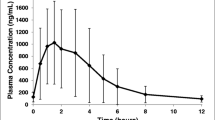Abstract
The retention of45Ca has been determined up to 388 days after an intravenous injection by measuring the urinary and faecal excretions and correcting for the loss from the skin. In the two healthy men examined, the urinary excretion rates were very similar but the faecal excretion rates differed by a factor of two. Retention expressed as dose minus excretion followed a power law after the first 4 or 7 weeks but at earlier times an additional exponential term was necessary to account for the data. Plasma concentrations of the dose were measured up to 15 days after the injection. The renal clearances for the two subjects were not significantly different.
Résumé
La rétention du45Ca a été déterminée pendant 388 jours après une injection intraveineuse en mesurant les excrétions urinaires et fécales et en tenant compte des pertes par la peau. Chez les deux hommes sains étudiés, les taux d'excrétion urinaire sont semblables, mais les taux d'excrétion fécale diffèrent par un facteur de deux. La rétention, exprimée en dose moin excrétion, suit une loi de puissance au bout des 4 ou 7 premières semaines mais, à une période plus précoce, un facteur exponentiel surajouté est nécessaire pour rendre compte des résultats. Les concentrations plasmatiques ont été mesurées jusqu'à quinze jours après l'injection. Les clearances rénales des deux sujets ne sont pas significativement différentes.
Zusammenfassung
Die Retention von45Ca wurde 388 Tage lang nach einer intravenösen Injektion bestimmt, indem Urin- und Stuhlausscheidungen unter Berücksichtigung des Verlustes durch die Haut gemessen wurden. Bei den zwei untersuchten gesunden Männern war die Geschwindigkeit der Ausscheidung im Urin sehr ähnlich, die Stuhlausscheidungsraten unterschieden sich jedoch durch einen Faktor von zwei. Die Retention, die als Injektionsdosis minus Ausscheidung ausgedrückt wurde, folgte nach den ersten 4 oder 7 Wochen einer Exponentialfunktion, vor diesem Zeitpunkt war aber noch ein zusätzliches Exponentialglied notwendig, um die Daten auszudrücken. Die entsprechenden Plasmakonzentrationen wurden 15 Tage lang nach der Injektion gemessen. Die Nieren-Clearance beider Männer waren nicht signifikant verschieden.
Similar content being viewed by others
References
Anderson, J., Tomlinson, R. W. S., Osborne, S. B., Wise, H. E.: Radiocalcium turnover in man. Lancet1967I, 930–934.
Barnes, D. W. H., Bishop, M., Harrison, G. E., Sutton, A.: Comarison of the plasma concentration and urinary excretion of strontium and calcium in man. Int. J. Radiat. Biol.3, 637–646 (1961).
Carr, T. E. F., Parsons, B. J.: A method for the assay of calcium-45 by liquid scintillation counting. Int. J. appl. Radiat.13, 57–62 (1962).
Cohn, S. H., Lippincott, S. W., Gusmano, E. A., Robertson, J. S.: Comparative kinetics of Ca47 and Sr85 in man. Radiat. Res.19, 104–119 (1963).
Comar, C. L., Wasserman, R. H.: Mineral metabolism, vol. 2A (C. L. Comar and F. Bronner, eds.), p. 523–572. New York and London: Academic Press 1964.
Harrison, G. E., Carr, T. E. F., Sutton, A.: Distribution of radioactive calcium, strontium, barium and radium following intravenous injection into a healthy man. Int. J. Radiat. Biol.13, 235–247 (1967).
Harrison, G. E., Raymond, W. H. A., Tretheway, H.: The metabolism of strontium in man. Clin. Sci.14, 681–695 (1955).
Heaney, R. P., Bauer, G. C. H., Bronner, F., Dymling, J. E., Lafferty, F. W., Nordin, B. E. C., Rich, C.: A normal reference standard for radiocalcium turnover and excretion in man. J. Lab. clin. Med.64, 21–28 (1964).
Heaton, F. W., Hodkinson, A.: External factors affecting diurnal variation in electrolyte excretion with particular reference to calcium and magnesium. Clin. chim. Acta8, 246–254 (1963).
Lederer, C. M., Hollander, H. M., Perlman, I.: Table of isotopes, 6th ed. New York: John Wiley & Sons, 1967.
Loutit, J.: Diurnal variation in the urinary excretion of calcium and strontium in man. Proc. roy. Soc. B162, 458–472 (1965).
Marshall, J. H., Rundo, J., Harrison, G. E.: Retention of radium in man. Radiat. Res.39, 445–451 (1969).
Nolan, J.: Liquid scintillation counting, vol. II. p. 147–154. London, New York and Rheine: Hayden & Sons 1971.
Norris, W. P., Tyler, S. A., Brues, A. M.: Retention of radioactive bone seekers. Science128, 456–462 (1958).
Rundo, J.: The retention of barium-133 in man. Int. J. Radiat. Biol.13, 301–302 (1967).
Spencer, H., Samachson, J., Laszlo, D.: Metabolism of strontium-85 and calcium-45 in man. Metabolism9, 916–925 (1960).
Wiseman, G.: Absorption from the intestine, p. 209. New York and London: Academic Press 1964.
Author information
Authors and Affiliations
Rights and permissions
About this article
Cite this article
Carr, T.E.F., Harrison, G.E. & Nolan, J. The long-term excretion and retention of an intravenous dose of45Ca in two healthy men. Calc. Tis Res. 12, 217–226 (1973). https://doi.org/10.1007/BF02013736
Received:
Accepted:
Issue Date:
DOI: https://doi.org/10.1007/BF02013736




